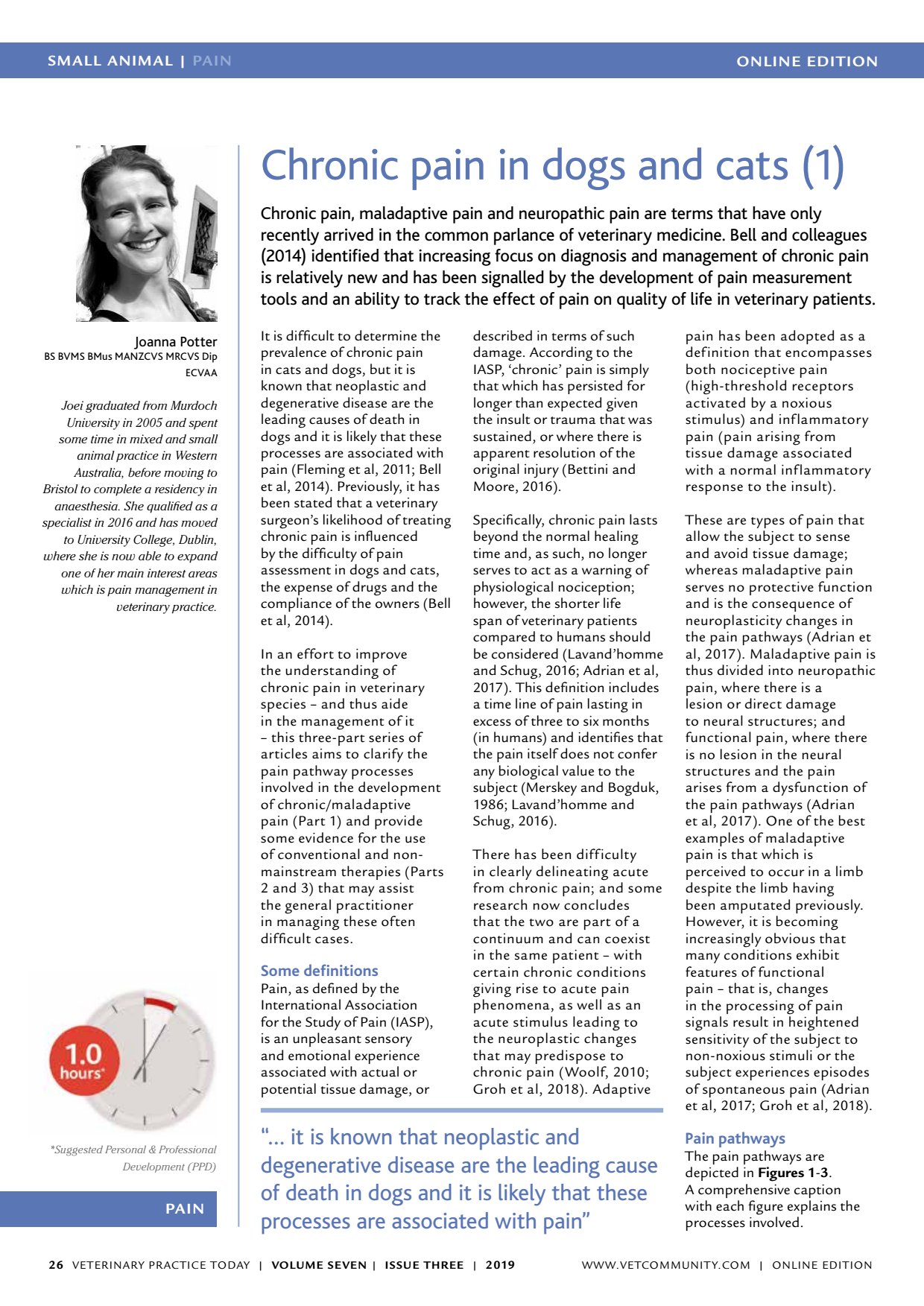Some definitions Pain
ONLINE EDITIONSMALL ANIMAL | PAIN VETERINARY PRACTICE TODAY | VOLUME SEVEN | ISSUE THREE | 2019 26 Suggested Personal & Professional Development (PPD) PAIN Joanna Potter BS BVMS BMus MANZCVS MRCVS Dip ECVAA Joei graduated from Murdoch University in 2005 and spent some time in mixed and small animal practice in Western Australia, before moving to Bristol to complete a residency in anaesthesia. She qualified as a specialist in 2016 and has moved to University College, Dublin, where she is now able to expand one of her main interest areas which is pain management in veterinary practice. Chronic pain in dogs and cats (1) Chronic pain, maladaptive pain and neuropathic pain are terms that have only recently arrived in the common parlance of veterinary medicine. Bell and colleagues (2014) identified that increasing focus on diagnosis and management of chronic pain is relatively new and has been signalled by the development of pain measurement tools and an ability to track the effect of pain on quality of life in veterinary patients. It is difficult to determine the prevalence of chronic pain in cats and dogs, but it is known that neoplastic and degenerative disease are the leading causes of death in dogs and it is likely that these processes are associated with pain (Fleming et al, 2011; Bell et al, 2014). Previously, it has been stated that a veterinary surgeons likelihood of treating chronic pain is influenced by the difficulty of pain assessment in dogs and cats, the expense of drugs and the compliance of the owners (Bell et al, 2014). In an effort to improve the understanding of chronic pain in veterinary species and thus aide in the management of it this three-part series of articles aims to clarify the pain pathway processes involved in the development of chronic/maladaptive pain (Part 1) and provide some evidence for the use of conventional and non- mainstream therapies (Parts 2 and 3) that may assist the general practitioner in managing these often difficult cases. Some definitions Pain, as defined by the International Association for the Study of Pain (IASP), is an unpleasant sensory and emotional experience associated with actual or potential tissue damage, or described in terms of such damage. According to the IASP, chronic pain is simply that which has persisted for longer than expected given the insult or trauma that was sustained, or where there is apparent resolution of the original injury (Bettini and Moore, 2016). Specifically, chronic pain lasts beyond the normal healing time and, as such, no longer serves to act as a warning of physiological nociception; however, the shorter life span of veterinary patients compared to humans should be considered (Lavandhomme and Schug, 2016; Adrian et al, 2017). This definition includes a time line of pain lasting in excess of three to six months (in humans) and identifies that the pain itself does not confer any biological value to the subject (Merskey and Bogduk, 1986; Lavandhomme and Schug, 2016). There has been diff iculty in clearly delineating acute from chronic pain; and some research now concludes that the two are part of a continuum and can coexist in the same patient with certain chronic conditions giving rise to acute pain phenomena, as well as an acute stimulus leading to the neuroplastic changes that may predispose to chronic pain (Woolf, 2010; Groh et al, 2018). Adaptive pain has been adopted as a def inition that encompasses both nociceptive pain (high-threshold receptors activated by a noxious stimulus) and inf lammatory pain (pain arising from tissue damage associated with a normal inf lammatory response to the insult). These are types of pain that allow the subject to sense and avoid tissue damage; whereas maladaptive pain serves no protective function and is the consequence of neuroplasticity changes in the pain pathways (Adrian et al, 2017). Maladaptive pain is thus divided into neuropathic pain, where there is a lesion or direct damage to neural structures; and functional pain, where there is no lesion in the neural structures and the pain arises from a dysfunction of the pain pathways (Adrian et al, 2017). One of the best examples of maladaptive pain is that which is perceived to occur in a limb despite the limb having been amputated previously. However, it is becoming increasingly obvious that many conditions exhibit features of functional pain that is, changes in the processing of pain signals result in heightened sensitivity of the subject to non-noxious stimuli or the subject experiences episodes of spontaneous pain (Adrian et al, 2017; Groh et al, 2018). Pain pathways The pain pathways are depicted in Figures 1 - 3 . A comprehensive caption with each figure explains the processes involved. it is known that neoplastic and degenerative disease are the leading cause of death in dogs and it is likely that these processes are associated with pain WWW.VETCOMMUNIT Y.COM | ONLINE EDITION
